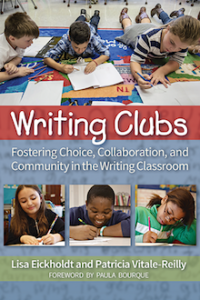Writing in Class with Choice and Community
Writing Clubs: Fostering Choice, Collaboration, and Community in the Writing Classroom
By Lisa Eickholdt and Patricia Vitale-Reilly
(Stenhouse Publishers, 2022 – Learn more)
Reviewed by Dawna Brandt
 Does the idea of teaching writing make you cringe? It has never been a strength of mine, so when I found Writing Clubs by Lisa Eickholdt and Patricia Vitale-Reilly, it piqued my interest, and it did not disappoint!
Does the idea of teaching writing make you cringe? It has never been a strength of mine, so when I found Writing Clubs by Lisa Eickholdt and Patricia Vitale-Reilly, it piqued my interest, and it did not disappoint!
The authors walked me through a step-by-step plan to engage my students in writing. They run their clubs all year, but change them up to keep engagement and interest high.

Their goal is to teach a short amount of time and let students practice for a long period of time. They spell out the materials needed, starting with a writer’s notebook. They believe that “a paper notebook requires you to write longhand, something recent brain research supports as a more effective way for humans to process and retain information” (10).
A variety of anchor charts and visuals are also a necessity. The charts should be colorful and visually appealing, but not overwhelming. Other tools include word walls, graphic or visual rubrics, and craft charts. Checklists are essential! They help students identify success criteria (Hattie 2009). Students also need a variety of paper, pens, inspiring quotes, mentor texts, and models.
I noted their quote, “teaching becomes a process of discovery in its own right.” I appreciated the many ways they demonstrated this philosophy throughout the book!
Launching a writing club
The next chapter helps you to “launch” the club in an exciting way. They begin by teaching students how to provide helpful feedback. This lifts the writer and helps them grow.
The process requires teaching two things: how to talk productively and respectfully, and how to talk about writing. “Creating a classroom community is one of the most vital aspects of teaching,” they say on page 20. I wholeheartedly agree with this.
During class they demonstrate how to give feedback by having a student sit in a feedback chair. The writer asks for specific feedback with the teacher offering choices to get this started.
Next, they talk about the power of partnerships. They do speed partnering in order for every student in class to partner with every other student at least once. Students take notes to refer to later. This shows the students that every child has unique qualities that may make them a good fit as a partner. The teacher uses a grid to keep track of the partnering and also notices especially good fits – students who seem more at ease as a talker or listener.
The stages of writing
The authors mention Donald Murray from The Leaflet saying, “The writing process is the heartbeat of writing.” They explain the three stages of writing: prewriting, writing, and rewriting. During these stages, the teacher will be giving mini lessons that the students can practice during their writing time.
I really enjoy how the authors include the dialogue between teacher and student! It gave me a sense of the class culture and the willingness to try new things. The teacher offered a draft of her own writing for the students to work on. They learned about different craft moves so they could later recognize these in the work of other writers.
Read a MiddleWeb article by
the co-authors of Writing Clubs
Read another review of Writing Clubs
by 7th grade teacher Katie Durkin
Read it through and then refer
This book is a great one to read all the way through the first time, and return to later for specific details and other references. It’s written in a very practical way, with the authors offering complete unit plans for different types of clubs.
The authors are very good at stating the objectives to their students and then reviewing them often. I also appreciate the low stakes writing that the students are expected to practice often. I am excited to use their ideas with my class this year!
Are you looking for lesson plans and ideas to engage your students as they learn writing skills? This is the book you’ve been waiting for! You’ll find teacher scripts that clearly show how to explain ideas and crafts. Ways to know which lesson to teach next. Checklists to keep your kids on track. Feedback techniques they can use with peers and for themselves. Ways to emulate other writers. Writing musts and mights.
All of these ideas and more are at your fingertips. Read this fast-paced book to level up your own writers!
Dawna Brandt has enjoyed working in education for over thirty years! Teaching kindergarten through fifth grade, she has spent most of her years teaching third grade. These darlings still have a zest for life and are becoming more independent, but don’t have a negative attitude. Instilling a love of learning is her primary goal. Her class has a culture of kindness and is a safe haven all day long. Dawna lives in northern California with her wonderful husband and fur-baby, Allie. She is an avid reader, likes to ride quads, and practices karate.


































